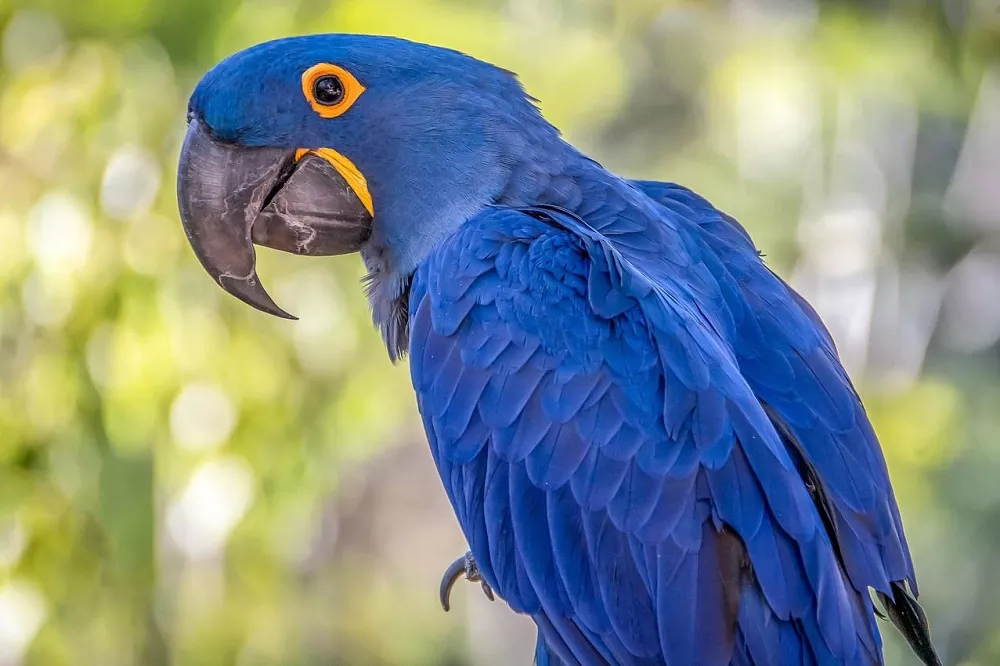The Hyacinth Macaw (Anodorhynchus hyacinthinus) is a strikingly beautiful bird native to South America. Known for its vibrant blue feathers, this majestic parrot is one of the largest members of the macaw family. In this article, we will explore the unique characteristics of the Hyacinth Macaw and delve into its distinctive coloration.
Appearance
Apart from its distinctive blue feathers, the Hyacinth Macaw has a large black curved beak that it uses for cracking nuts and seeds. Its eyes are surrounded by a ring of bright yellow skin, and its feet are zygodactyl, meaning two toes face forward, and two face backward. The bird’s wingspan can measure up to 4 feet, and it can weigh up to 3.7 pounds.
Habitat
Hyacinth Macaws are native to central and eastern South America, ranging from Brazil to Paraguay and Bolivia. They inhabit a variety of habitats, including forests, savannas, and palm groves, and can often be found near rivers or swamps. Unfortunately, due to habitat loss and the illegal pet trade, these birds are now classified as Vulnerable by the International Union for Conservation of Nature.
Diet
The Hyacinth Macaw primarily feeds on nuts and seeds, particularly from the manduvi tree. They also consume fruits, berries, and occasionally insects and small vertebrates. These birds play an important role in dispersing seeds, which helps to maintain healthy ecosystems.
Breeding
Hyacinth Macaws are monogamous and form lifelong bonds with their mates. They nest in tree cavities and typically breed during the rainy season when food is abundant. The female lays 1-3 eggs, and both parents take turns incubating them for about a month. The chicks fledge after approximately 3 months and become independent after 6-9 months.
Coloration
The Hyacinth Macaw is best known for its vibrant blue feathers, which range from a deep navy to a lighter cobalt shade. The intensity of the blue can vary depending on the angle of light and the bird’s age. Younger birds tend to have darker feathers that become lighter as they mature. In addition to their blue plumage, these birds also have black feathered faces and striking yellow eye patches.
The coloration of the Hyacinth Macaw is due to the presence of pigments called psittacins, specifically psittacin A and B. These pigments are not found in most other birds, making the Hyacinth Macaw’s blue hue even more unique. Interestingly, the blue coloration is not limited to just the feathers—their skin and even their bare parts such as the tongue and cere are shades of blue!
Conservation
Unfortunately, the Hyacinth Macaw population has declined significantly due to habitat loss and poaching for the illegal pet trade. The birds are still captured for the pet trade despite being protected by law. However, conservation efforts such as habitat protection, nest box programs, and community education have helped to stabilize some populations. Zoos around the world also participate in captive breeding programs to help ensure the survival of the species.
Conclusion
In conclusion, the Hyacinth Macaw is a stunning bird with unique characteristics and an unmistakable blue coloration. Despite being threatened by habitat loss and poaching, conservation efforts are underway to protect these magnificent creatures. It is important to appreciate and protect the natural beauty of the Hyacinth Macaw and all the other amazing species that share our planet.


 Facebook
Facebook  Instagram
Instagram  Youtube
Youtube 